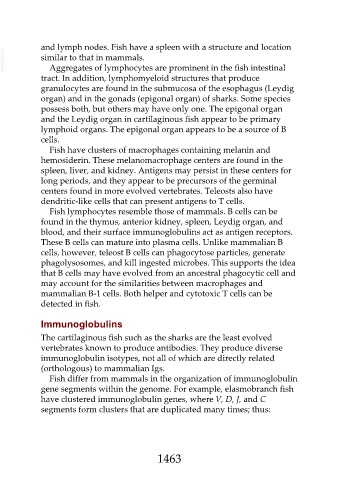Page 1463 - Veterinary Immunology, 10th Edition
P. 1463
and lymph nodes. Fish have a spleen with a structure and location
VetBooks.ir similar to that in mammals.
Aggregates of lymphocytes are prominent in the fish intestinal
tract. In addition, lymphomyeloid structures that produce
granulocytes are found in the submucosa of the esophagus (Leydig
organ) and in the gonads (epigonal organ) of sharks. Some species
possess both, but others may have only one. The epigonal organ
and the Leydig organ in cartilaginous fish appear to be primary
lymphoid organs. The epigonal organ appears to be a source of B
cells.
Fish have clusters of macrophages containing melanin and
hemosiderin. These melanomacrophage centers are found in the
spleen, liver, and kidney. Antigens may persist in these centers for
long periods, and they appear to be precursors of the germinal
centers found in more evolved vertebrates. Teleosts also have
dendritic-like cells that can present antigens to T cells.
Fish lymphocytes resemble those of mammals. B cells can be
found in the thymus, anterior kidney, spleen, Leydig organ, and
blood, and their surface immunoglobulins act as antigen receptors.
These B cells can mature into plasma cells. Unlike mammalian B
cells, however, teleost B cells can phagocytose particles, generate
phagolysosomes, and kill ingested microbes. This supports the idea
that B cells may have evolved from an ancestral phagocytic cell and
may account for the similarities between macrophages and
mammalian B-1 cells. Both helper and cytotoxic T cells can be
detected in fish.
Immunoglobulins
The cartilaginous fish such as the sharks are the least evolved
vertebrates known to produce antibodies. They produce diverse
immunoglobulin isotypes, not all of which are directly related
(orthologous) to mammalian Igs.
Fish differ from mammals in the organization of immunoglobulin
gene segments within the genome. For example, elasmobranch fish
have clustered immunoglobulin genes, where V, D, J, and C
segments form clusters that are duplicated many times; thus:
1463

